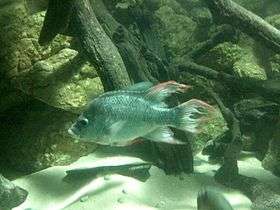Ptychochromis insolitus
| Ptychochromis insolitus | |
|---|---|
 | |
| Male at London Zoo | |
| Scientific classification | |
| Kingdom: | Animalia |
| Phylum: | Chordata |
| Class: | Actinopterygii |
| Order: | Perciformes |
| Family: | Cichlidae |
| Subfamily: | Ptychochrominae |
| Genus: | Ptychochromis |
| Species: | P. insolitus |
| Binomial name | |
| Ptychochromis insolitus Stiassny & Sparks, 2006 | |
Ptychochromis insolitus, also known as the Mangarahara cichlid, is a species of cichlid endemic to certain river systems in northern Madagascar. It was first described in 2006 but was then thought to have disappeared, before a remnant population was discovered in 2013. The fish, just 5.5 cm (2.2 in) long, is threatened by habitat loss and introduced species and the International Union for Conservation of Nature has assessed it as being "critically endangered". The fish found in 2013 have been moved into captivity where attempts are being made to breed them.
Status
The Mangarahara cichlid was first described as a new species in 2006 from the Amboaboa and Mangarahara Rivers near Mandritsara in northern Madagascar.[2] It is listed as Critically Endangered by the IUCN, but until its rediscovery in 2013, it was feared that the last remaining wild population had disappeared.[3] This rare species is threatened by habitat loss and introduced species.[1] Prior to its official description, it was sometimes known as Ptychochromis sp. nov. "Joba mena" or Ptychochromis sp. nov. "Mangarahara".[1][2] Two cichlids from another genus, Paretroplus nourissati and P. gymnopreopercularis, and a round herring, Sauvagella robusta, are restricted to the same region as Ptychochromis insolitus.[4][5] This species can reach a length of 5.5 centimetres (2.2 in) SL.[6]
In captivity
As of 2013, only three specimens were known to exist in captivity; two males in London Zoo and one male in the Berlin Aquarium. An appeal to collectors was put out in May 2013 to attempt to find a suitable female in a private collection for breeding purposes.[7] The last known female was killed by a male at the Berlin Aquarium while trying to mate.[8] In late 2013, a remnant population was discovered in the wild after a local tip-off, and 18, including some females, have been moved into captivity.[3]
References
- 1 2 3 Loiselle, P. & participants of the CBSG/ANGAP CAMP "Faune de Madagascar" workshop, Mantasoa, Madagascar 2001 (2004). "Ptychochromis sp. nov. Joba mena". IUCN Red List of Threatened Species. Version 2011.1. International Union for Conservation of Nature. Retrieved 15 July 2011.
- 1 2 Stiassny, M., and Sparks, J. S. (2006). Phylogeny and Taxonomic Revision of the Endemic Malagasy Genus Ptychochromis (Teleostei: Cichlidae), with the Description of Five New Species and a Diagnosis for Katria, New Genus. American Museum Novitates 3535.
- 1 2 "Conservation Hail Mary works: Mate for near-extinct fish found!". Mongabay.com. 20 December 2013. Retrieved 22 December 2013.
- ↑ Sparks, J. S. (2008). Phylogeny of the Cichlid Subfamily Etroplinae and Taxonomic Revision of the Malagasy Cichlid Genus Paretroplus (Teleostei: Cichlidae). Bulletin of the American Museum of Natural History Number 314 :1-151
- ↑ Stiassny, M.L.J. (2002). Revision of Sauvagella Bertin (Clupeidae: Pellonulinae: Ehiravini) with a description of a new species from the freshwaters of Madagascar and diagnosis of Ehiravini. Copeia 2002(1): 67-76.
- ↑ Froese, Rainer and Pauly, Daniel, eds. (2013). "Ptychochromis insolitus" in FishBase. April 2013 version.
- ↑ "Zoo seeks mate for last surviving 'gorgeously ugly' fish". BBC News. 10 May 2013. Retrieved 10 May 2013.
- ↑ harpers.org july 2013
